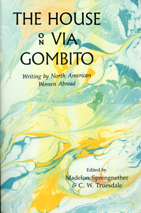If you stare across the lagoon from the northern edge of Venice, the world seems an immense roil of waves, tongues of land lapping out of them, and sky contesting above for prominence. In the Cinquecento, 1500s, with only candle and lamplight, interiors must also have risen into the heights of vaulted ceilings and domes with the same cloudy immensity.
Before I came to Venice this October, Tintoretto was simply the name of a painter, less important than his grand Venetian contemporary, Titian, one of a few late Renaissance masters whose work had barely impressed itself upon me. That’s all changed. Venice is Tintoretto’s playground, and the play is so immense, so vividly charged with chiaroscuro–that wonderful Italian word meaning light-dark–that you feel the man must have continually dipped his brush in the city’s vast watery essence. The painting above, “Presentation of the Virgin in the Temple,” hangs in the church of Madonna dell’Orto, near Tintoretto’s family chapel, for it was his family church. Two other immense works of his also transform the altar area: “Worship of the Golden Calf,” and a “Last Judgment.” These are all huge works, wide and tall. My favorite, the Presentation pictured here, hangs to the left of the altar against a wall, and thus takes part the natural play of chiaroscuro of the church itself.
The church of Madonna dell’Orto is in the northern area of the city called the Canareggio. The church has a lovely rounded top to what we’d call its steeple; its made of warm red brick with edgings of off-white stone. A spacious piazza opens in front of the church, leading to one of Venice’s ever present canals. As I stood admiring the church, a large, immature herring gull descended on large, mottled-grey wings and strode about, looking for grubs, perhaps, or bits of bread. Herring gulls are the biggest gulls I saw among the many white gulls following the boats or wheeling over the canals. Venice is not a city filled with parks–it guards its bits of land jealously for piazzas–those like the one in front of San Marco and the Ducal Palace crammed with people, and those like the several I crossed frequently from the northern edge of the city as I made my way south toward the Grand Canal, the Arsenale or a few times toward San Marco.
Thousands of bridges cross hundreds of canals. I had to smile at myself: the map I brought from home showed only a few bridges. How do the Venetians get across their canals? I wondered in my innocence. The experience of Venice on foot is largely that of climbing up and down the steps of bridges. This is exactly the effect Tintoretto has captured in the “Presentation of the Virgin.” Light sweeps across Saint Anne’s robust figure and follows her hand pointing up toward the temple. She and little Mary are climbing up steps, as do thousands of citizens everyday, crossing their many bridges.
What’s so compelling about this painting is its daring use of chiaroscuro to compel the two figures up the steps. Their backs are toward us–the meaning of their action is read entirely in their bodies’ motion. Beside them loll another mother and child–at first I was sure this was a prostitute or courtesan, but perhaps not. Perhaps merely a less ardent mother, less devoted to her child’s religious education, less compelled by fate. In any case, the contrast emphasizes the action of Saint Anne and little Mary. The mother points the way, pushes the child forward, they will reach the top–which my camera couldn’t capture, but which is not at all the focus of the work. It’s the effort, the zeal of the climb that Tintoretto had poured into their figures.
He was evidently a religious man who often (especially at the beginning of his almost entirely self-taught career) gave works to religious sites, but who was not at all laggard in pushing himself forward. In competition for the commission to decorate the Scuola Grande di San Rocco he positioned his entry on a wall of school–outbidding all others simply by hanging his entry where it eventually would go. The work he did for this religious school took him twenty years and accounts for some of his most lavish works, loosely painted, full of motion and chiaroscuro–very effective when viewed on high from below.
I studied one other Tintoretto, “Adoration of the Shepherds,” an earlier work which hangs in the Castello in Verona. As the placard (or was it the printed guide) noted, the faces show no emotion, but the figures of Mary and baby, Joseph and shepherds, and a lovely young woman wearing cloth of gold, even the head of the sympathetic cow pushing into the scene–all display their adoration through the motion of their bodies, motion as if caught in a moment of intense desire to see, to relate, motion so huge and fleeting it must have been snapped by a camera. The drapery molding the thighs and knees and legs of the old shepherd, drapery on Mary’s legs and shoulders and arms, the bend head of Joseph leaning for strength on his staff, the doffed cap of a young shepherd as he holds his hand to his heart–all this motion as the baby Jesus himself lifts his haloed head off his pallet of straw to welcome the visitors.


Leave a Reply